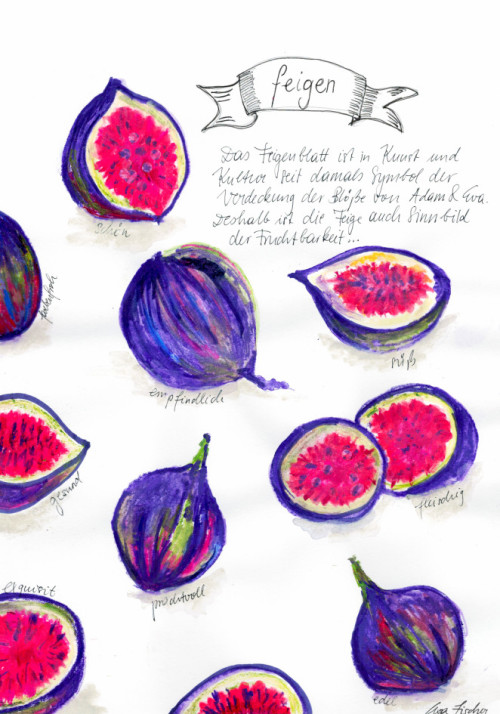On Figs… and Some Delicious Fig Chutney
„Then the eyes of both were opened, and they knew that they were naked. And they sewed fig leaves together and made themselves loincloths." (Genesis 3:7). The fig tree was the first tree named in the bible. The fig leaf has been a symbol of chastity as well as fertility ever since Adam and Eve covered up their bits with it.
The fig is one of the oldest fruits in the world. It is believed that the fig tree, which belongs to the mulberry family, originally came from the Middle East. In ancient times, figs were an important basic staple. Today, they are chiefly grown in Spain, Algeria, Greece, Turkey, Portugal and Italy. The popular Calymirna variety mostly stems from California.
Figs can look a little different depending on type. There are yellow, green, purple and reddish brown ones. The colour palette in the pulp ranges from a whitish pink to a strong crimson. There are about 150 different types of fig in total.
Did you know that the fig isn't actually a fruit, but rather the scion - something like a fruity blossom - of the fig tree? The tree itself can reach a height of up to 10 metres.
What's in a fig?
Figs contain a ton of healthy ingredients. Their healing properties have been well known for a long time. They don't just pack plenty of fructose and fibre, but also iron, potassium and calcium as well as vitamin B1. Figs contain a lot of water - almost 80%. Aside from that, a ripe fig is around 1,3% protein, 0,5% fat, 12,9% carbohydrates, around 4,5% fibre and 0,7% minerals. They are considered to have blood-purifying, diuretic and digestive properties. The concentration of ingredients is higher in dried figs than in fresh ones, so their effect and energy content is higher as well.
Another interesting piece of trivia: figs are the most alkaline of foods around, so they are ideal for neutralising acidic dishes - this is key for people who eat a lot of meat and sausages and not enough fruit and veggies.
How do you store figs correctly?
You should keep fresh figs in the fridge, side by side, ideally, as opposed to on top of each other. Unfortunately even in a cool environment, they don't last very long, so your best bet is to eat them right away.
Use and prep in cooking
The skin of a fig is very edible. If you'd rather peel them, halve them and scoop out the soft pulp with a spoon.
Figs enhance any salad and work really well with goat's cheese and ham. They're also great with hearty main courses like intense meat sauces with port.
And they're particularly yummy in desserts or breakfast dishes, especially in combination with honey, yoghurt and nuts.
A Big Jar of Fig Chutney
Ingredients:
- 3 small or 2 large onions
- 6-8 figs
- 3 TBSP brown sugar
- 1 tsp mustard seeds
- 1 pinch of chilli powder
- 3 sprigs thyme
- 3 TBSP olive oil
- 3 TBSP balsamic or raspberry vinegar
- 1/2 lemon
- 3-4 TBSP white wine
- salt and pepper
Preparation:
- Peel anf finely chop the onion. Wash and finely cube the figs.
- Heat up the olive oil in a pan and fry the onion until translucent. Add the sugar and let everything caramelise.
- Wash shake dry and pick the thyme. Add the figs, chilli powder, thyme and mustard seeds, increase the heat and steam for 4 minutes while stirring continuously. Deglaze with wine, stir in the vinegar and cook the chutney over a low heat for 30-40 minutes. Stir occasionally.
- Squeeze the lemon. Season the chutney with salt, pepper and a teaspoon of lemon juice, to taste. Fill the finished chutney into jam jars and keep in the fridge.
Notes:
Tastes great with cheese.




